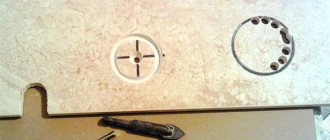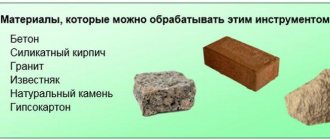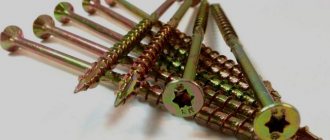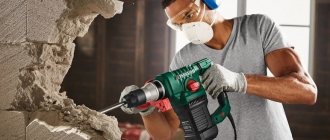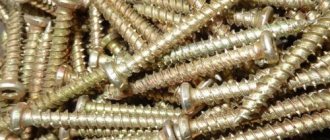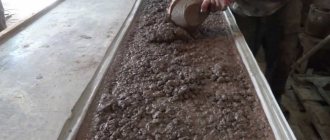SHARE ON SOCIAL NETWORKS
FacebookTwitterOkGoogle+PinterestVk
Recently, not only everyday life has become more comfortable, but also such a troublesome process as repairs, which are compared to a flood or fire. Probably, the crumbs and concrete dust that fill the room when holes are made in the walls really have something in common with a natural disaster. All this is in the recent past. Modern tools, including a concrete crown, have made the drilling process much more technologically advanced.
Crowns speed up and simplify the installation of the undercut, ensuring accuracy and precision of work
How and how to drill holes for socket boxes in concrete
It is necessary to make recesses in concrete quite often, including when performing electrical wiring. Furrows are made using wall chasers. But the places for switches and sockets are prepared in a different way.
Concrete crown - a piece of metal pipe made of tool steel
To determine the center, you first need to mark a cross on the wall using a tape measure and a pencil. Then you need to outline the intended circle, use a drill to make four holes at the intersection of the circle and straight marking lines, as well as in the center. After this, you will need a special concrete cutter, that is, a crown.
It is a piece of metal pipe, one end of which has teeth made of high-strength material, and on the second there is a flange with which the device is fixed to the rotation mechanism. The shank has a hole for attaching a centering drill, which ensures the desired direction of rotation of the crown. The drill always comes complete with a cutter. If it is necessary to make a through hole in thick walls, use an extension for a concrete crown. It significantly expands the operational capabilities of the device.
The advent of crowns greatly simplified the process of making holes. When performing work with a drill and then knocking out concrete with a chisel, not only a lot of physical effort and time is spent, but the recesses themselves turn out to be uneven.
The crown allows you to create technological holes of large and small diameters
Video description
This video shows the installation of socket boxes:
Preparing socket boxes
Before installation, the side window is broken out in the box. Wires are pulled through the resulting opening to a length of about 10 cm. The ends of the wires are stripped and crimped with a terminal block. Contact elements are necessary for stranded conductors. Shaggy twists often lead to a short circuit and, even worse, can cause a fire in the wiring.
Perforated openings in the glass are located on four sides on the side of the PR. This is done so that you can pull the wire into the box from any direction without creating unnecessary twisting of the wiring.
PR installation
- The hole in the concrete is cleaned of dust and moistened with water to increase the adhesion of the concrete surface of the nest.
- Gypsum or alabaster is diluted with water in a ratio of 1:2.
- The solution is applied with a spatula in a circle inside the hole.
- The box with the stretched wire is inserted into the seat.
- The squeezed out solution is removed.
Removing excess solution Source www.sibelektrika.ru
Connection and installation of fittings
After the alabaster hardens, the following actions are performed:
- the stripped ends of the wires or terminals are secured to the switch block or socket;
- Usually the terminals are secured with screws and washers.
- There are fittings with self-clamping fasteners. The ends of the wires are inserted into the holes, and spring-loaded bars clamp them;
- the wire is laid on the bottom of the socket box and the fittings are inserted;
- The pad pad with the holes is put on the PR screws and turned until it is level. The screws are tightened with a screwdriver;
- the side screws of the block are tightened until the sliding legs reach maximum contact with the surface of the glass;
- The switch keys are inserted into the sockets of the block. Then the front frame is attached. The front panel of the socket is screwed to the block with a screw.
Fastening the socket fittings in the socket box Source sense-life.com
The main types of concrete crowns for sockets
The cylindrical element of all crowns is the same, but depending on the material from which the cutting part is made, there are several types of crowns for sockets on concrete:
- with cutting elements made of hard metal alloys;
- from tungsten carbide alloys (pobedite);
- with diamond coating.
The method of operation of the hammer drill also depends on the characteristics of the cutting part. For diamond and tungsten carbide bits, a non-impact drilling method is suitable; for metal bits, in which the cutting part is shaped like teeth, an impact method is used.
A metal crown can only be used for concrete without reinforcement. The impact effect significantly reduces the service life: such crowns cannot be restored. They are used more often for domestic needs when it is necessary to make a small number of holes.
The crown can be prefabricated or a single structure
Tungsten carbide bits are also only suitable for unreinforced concrete. They are quite convenient to use when making holes in walls with a tiled surface.
Diamond-coated crowns are the most common option. They have a continuous ring coating along the edge. They can make holes in reinforced concrete without using the impact method, which is gentle on the supports of the structure to be drilled.
Helpful advice! When purchasing, you should keep in mind that using a diamond bit most often requires running water. It cools the cutting edge from overheating, while simultaneously removing sludge and dust generated during the drilling process
What to do if the socket box falls out of the wall
The reason for this may be improper fastening of the PR in the socket. If this happens and the socket box is undamaged, proceed as follows:
- remove the front panel of the socket, switch keys and frame;
- unscrew the screws of the spacer legs and the pad pad;
- the fittings are removed from the socket box;
- the seat is cleaned of dust and alabaster residues;
- the nest is coated with a primer using a brush;
- the hole is filled with alabaster or gypsum mortar;
- The installation of the box is repeated.
The operating principle of diamond bits for concrete
Diamond bits can vary in diameter, connection method to the shank, size, quality and shape of the cutting segments. Products marked “M”, that is, with a soft cutting coating, are used for working with hard concrete surfaces. They self-clean from dust generated during operation, which makes the drilling process more efficient.
Diamond core bits are used for drilling reinforced concrete using a non-impact method, which protects load-bearing structural elements
Depending on the size of the cylinder, a diamond bit can have 5 cutting elements with a diameter of 6.5 cm or 32 cutting segments for a device with a caliber of 65 cm.
For standard grades of concrete, crowns marked “C” are used, indicating that the spraying has medium hardness. Coating “T” (hard) is used when operating devices at reduced speeds.
Diamond bits for drilling concrete can work with both dry and wet drilling methods. Nozzles designed for drilling without water supply have specially shaped holes in the cylinder body that help cool the edge during operation.
Diamond bits easily pass through reinforcement. During drilling, the concrete layer is destroyed only under the edge; at the end of the work, a cylinder of stone remains in the crown.
Diamond bits for concrete are equipped with soldered wide cutting segments with diamond abrasive
When making holes of significant diameter and depth, the drilling machine can be secured using anchors. This position promotes more accurate drilling, does not create a lot of dust, prevents jamming of the cylinder and reduces the noise level. Holes for socket boxes are often made manually.
Features when working with reinforced concrete and tiles
Reinforced concrete drills provide drilling of the strongest materials with maximum diameter and depth, which other similar products cannot cope with. It is thanks to this ability that this model received first place in the rating of tools.
Such a part, unlike Pobedit products, is reliable and durable, and if you purchase it for regular construction and repair work, its high price will pay off in a short period of time. Even the presence of reinforcement cast in concrete will not prevent you from equipping a special place for the socket box using a similar attachment.
Ceramic tiles are a rather difficult material to cut and, especially, drill into a certain surface. Until recently, it was almost impossible to drill into tiles without compromising its integrity; however, the advent of diamond parts has simplified this process. Now ceramics can be used for pipe routing, installation of various fasteners for decorative elements, it can be grooved for laying wires, installing sockets and switches in specially equipped socket boxes.
Standard diameters of crowns for concrete
Holes and recesses in concrete, both for domestic and industrial purposes, may be needed not only for installing sockets, but also when laying pipes, cables, etc. Consequently, the sampling parameters will not be the same, which means that tools with various dimensional indicators: with a certain diameter for socket boxes, for pipes - depending on the cross-section, for cables - in accordance with the dimensions of the route.
Each product is accompanied by instructions, which necessarily indicate the characteristics of the crown, or this information is indicated on the marking.
Crown heads have a wide range of diameters and lengths
Helpful advice! If the diameter of the socket boxes is unknown, you should take measurements with a caliper along the outer edge of the product and purchase a crown in accordance with the obtained indicator.
Concrete drill bits for hammer drills can be sold separately or as a set. Purchasing a kit is advisable if the use is not occasional. Kits, as a rule, contain 5-10 crowns of various diameters, which will allow you to make a hole of any standard size if necessary. Rigid packaging and compact placement of tools in it do not cause problems during storage and help protect products from damage associated with external environmental influences.
Types and cost of crowns for 68 mm concrete
The sizes of boxes for installing sockets and switches are standard. The recesses for them are made using 68 mm concrete crowns. This is the most common option.
For carbide (pobedite) options, the cutters are set at a negative angle of 7°. This arrangement dampens the intensity of the dynamic load on the nozzle and reduces the impact of radial and axial runout. This attachment can be used for rotary hammers with a power of 850 W or more. The SDS Plus system is used as fastening.
68 mm concrete crowns are considered the most common option
A diamond crown with a diameter of 68 mm most often has 4 coated segments. These fragments are made by mixing diamond chips and metal powder. The composition is pressed, resulting in the formation of elements of the desired shape and size, which are then baked. The power of the hammer drill to use this type of attachment must be at least 600 W, the recommended speed is 1000-3500 rpm, the type of attachment is SDS Plus.
The most commonly used bits coated with tungsten carbide have a medium grain and are recommended for working on brick, facing and tiles, foam concrete, and hard gypsum. The optimal speed when working with such attachments is 1500 rpm.
The average price of a diamond drill bit for 68 mm concrete is 7-10 thousand rubles. For pobedite species (coated with tungsten carbide) it is significantly lower - 4-6 thousand rubles. The cost of metal products is 450-600 rubles.
The hammer drill must have a power of at least 600 W to use bits with a diameter of 68 mm
Scope and methods of application of diamond bits for concrete 72 mm
A diamond bit with a diameter of 72 mm is also a fairly commonly used attachment. It is used when making recesses for socket boxes, distribution boxes, or when laying communication pipes. Used with a drill or hammer drill. Crowns of this diameter are divided into two types:
- for dry drilling;
- for wet drilling.
Nozzles recommended for dry work have oppositely placed cutouts on the sides of the cylinder, which ensure cooling of the cutting edge during operation. Options without holes in the cylindrical body require the use of running water for cooling.
Diamond bits for concrete 72 mm are used when working in non-impact mode. With their help you can drill concrete, reinforced concrete, natural and artificial stone, and ceramics. The recommended power of the rotating device is 700 W or higher, rotation speed is 1500-2000 rpm. The cutting fragments of the cutters are laser welded, which further enhances the strength of the attachment.
Using bits with a diameter of 72 mm you can drill concrete, natural and artificial stone, ceramics
Helpful advice! If during operation the rotation speed of the power tool slows down significantly, you should not increase the pressure on the bit. This will not improve efficiency, but will cause wear on the cutting edge.
Features of using crowns for 100 mm concrete
During construction or renovation work, it is often necessary to drill large holes, especially for connecting water supply and sewerage. In such cases, a crown with a diameter of 100 mm is used. You can purchase such a cutter made of hard metal. It is inexpensive - 400-450 rubles. You should not be afraid when purchasing such a cutter made in China; its performance is not inferior to its Russian counterparts.
Related article:
Attachments for an angle grinder: a variety of tools for angle grinders
Nozzles for an angle grinder. Their characteristics. Classification by material and purpose. Cutting, roughing and grinding devices. Wall chaser attachment. Grinder on a chainsaw..
Such a crown for concrete should be given time to cool, and the impact function of power tools should be used. A distinctive quality of this type of cutter is its fairly rapid wear. If it gets on the reinforcement, the cutting edge is significantly damaged, so its further use is called into question. Before starting work, you need to be sure that there are no metal elements along the drilling path.
To drill large holes, use a crown with a diameter of 100 mm
Diamond bits for drilling concrete are more durable in operation when making holes, especially for drilling large holes. If the amount of work to be done is significant, it is worth purchasing the latter option. Even at a significantly higher price (compared to metal crowns), such a cutter may turn out to be more cost-effective.
Concrete crown 110 mm: application and specifics of fastening
The diameter of metal bits does not exceed 100 mm, so to drill holes 110 mm or larger you need to purchase a diamond-coated cutter.
To work with a nozzle of this size, you will need an electric drill or hammer drill with a power of at least 100 W.
When working on concrete with a 110 mm bit, it is better to use water cooling. It will prevent overheating and falling off of the soldered edge.
Crowns with a diameter of 110 mm are attached using two types of adapters
Some difficulties may arise in the process of attaching the attachment to the power tool. The main part of the bits is compatible with rotary hammers and drills. As for options with large diameters (150 mm or more), some models require a special size of connecting elements. There are two types of cartridges, which play a major role in the mounting method:
- SDS-plus. They are part of the design of low-power tools whose weight does not exceed 5 kg.
- SDS-max. They are equipped with heavier and more powerful models of rotary hammers.
The attachment must have the appropriate shank to match the type of attachment.
The industry produces adapters that allow you to install a crown of one type on a chuck for another purpose.
To work with a 110 mm nozzle, you will need a hammer drill with a power of at least 100 W
Important! You cannot purchase and install a 110 mm concrete bit for a hammer drill with a power of 800 W or less. Using an adapter makes it possible to connect the structure, but this does not affect the operation of the engine. A large crown on a low-power power tool contributes to inevitable overheating with the ensuing consequences.
Price
Different dental crowns have different prices, depending on the material being made, the creation method, the professionalism of the doctor, the location and status of the clinic.
Let's look at the approximate prices of different types of crowns (per unit):
- porcelain - 13 thousand rubles;
- from zirconium dioxide - 16 thousand rubles;
- metal-ceramic - 6 thousand rubles;
- plastic - 800-1000 rubles;
- metal - 3 thousand rubles;
- metal-plastic - 4 thousand rubles;
- metal-ceramic for installation on implants - 10-14 thousand rubles;
- zirconium together with an abutment - 25 thousand rubles.
We offer an overview of turnkey prices in Moscow clinics for prosthetics:
| Clinic | Address | Price |
| Dentistry Mendeleev | St. Novoslobodskaya street, 36/1с1 | From 7900 rub. |
| Dentistry ActiveStom | 4th lane Krutitsky, 14 | From 2500 rub. |
| Dental-Studio | Michurinsky Prospekt, 80 | From 6000 rub. |
| Doka-Dent | St. 1st Tverskaya-Yamskaya, 27 | From 2500 rub. |
Crowns for concrete sockets: review of manufacturers
There is quite a large selection of crowns on the market. Among those that have confirmed high quality and good performance characteristics is Super Hard. This is an American company with representation in various regions. Nozzles with a diameter of up to 80 mm provide drilling through materials of various qualities, including reinforced concrete.
Crowns for domestic hammer drills are also in demand. The company produces three types of nozzles:
- G series. High speed and good performance for concrete grades M100-M300;
- S series. Recommended for concrete M400-M600;
- TOP series. Used when working with heavy material.
DeWalt crowns are available in all standard sizes
Crowns produced by Bosh have gained popularity and trust among consumers. They confirm excellent German quality. Nozzles with a diameter of 68 mm are especially in demand.
The DeWalt (American manufacturer) line of crowns is represented by models of all existing standard sizes. They can drill to a depth of up to 80 mm. The prices of DeWalt concrete crowns can be attributed to the middle segment. For example, a wear-resistant, popular version of a 68 mm diamond-coated nozzle will cost an average of 7,000 rubles.
Domestic cutters produced by Enkor are quite competitive. Particularly worth highlighting is model 48280. This is a diamond bit that can be used when working with all types of concrete, including reinforced concrete, as well as drilling stone and ceramics. It is recommended to work with it in shockless mode. The cylinder has holes for cooling.
Balance of price and quality: crowns for concrete “Distar”
Almost every buyer wants to purchase a quality product at the most reasonable price. Diamond-coated products of the Distar brand meet these requirements. For 25 years now, the company has been supplying the market with tools that are successfully used both in everyday life and for industrial purposes.
Distar bits can be used as attachments for different types of power tools
Diamond bits for concrete 68, 72, 82 mm are the most popular models. They have a significant service life and good drilling speed. Among this type of nozzles, most have holes for cooling, so there is no need to connect water. Diamond-coated segments have a specific shape that allows cuttings to be drained away, thereby cleaning the drill from drilling waste that reduces operating efficiency.
“Distar” crowns, depending on the characteristics of the material to be drilled, are divided into three categories:
- for ceramics and metal ceramics;
- for marble and granite;
- for concrete and reinforced concrete.
Crowns can be used as attachments for different types of power tools with torque: hand drills, rotary hammers, as well as stationary drilling machines.
Distar products have a universal adapter that ensures quick replacement and compatibility with other equipment
You can always choose a version of a product from a given manufacturer with the required shank, comparable to the design features of the electrical equipment used. For the fastening element of SDS Max, SDS Plus concrete drills from Distar, you can achieve a match with a drill or hammer drill by using a 1 ¼ UNC adapter and other types of adapters.
Helpful advice! When choosing an adapter, you must carefully read the information on the product label. If you have the opportunity to test the adapter directly when purchasing it in a store (you should take a power tool with you), it is better not to neglect this method of testing. It will avoid problems and ensure full functioning of the nozzle.
Application
Before starting work, it is necessary to carefully and thoroughly prepare the tool for use.
Assembly
Before use, the tool must be properly assembled:
- the first thing to do is to insert a drill from Pobedit, it is secured with bolts;
- further, the bowl is attached to the thread;
- check the assembly: it should be strong, nothing should wobble.
If assembled incorrectly, it is possible to break the drill or bowl, and the craftsman may be injured.
Drilling
After assembly they start working. To do this, use a hammer drill or impact drill. A conventional drill can also be used, for example, for drilling crowns into ceramic tiles or materials of minor thickness and hardness. Drilling concrete of normal thickness with a conventional drill to the depth required for a socket will take half a day, so it is better to use a hammer drill.
First, markings are made at the site of the future socket box, and a point for the centering drill is marked. He is directed into it and drilled. In this case, use safety glasses, a respirator, and construction gloves. After drilling, remove the tool and knock out the central part. This is done with a simple hammer drill, chisel, or hammer. Diamond core bits make a hole with very smooth walls. After drilling, you need to let the crown cool down - this way the soldering will last longer.
Lifetime of diamond bits for concrete for socket boxes
The resource of the crown depends on objective and subjective indicators. The first should include the characteristics declared by the manufacturer. They depend on the characteristics of the cutting segments and the quality of the material intended for processing. For example, a concrete bit with a diameter of 200 mm, which has a saturated diamond coating, is designed for 18-20 linear meters of drilling in reinforced concrete.
The 68 mm SDS Plus diamond bit for concrete can cover 14 linear meters under optimal conditions. The larger the diameter of the crown, the more significantly its resource increases. It is ensured by the presence of a large number of diamond-coated cutting segments.
The nominal life will be confirmed only under conditions of proper use of the crown.
Subjective reasons affecting the resource of the nozzle include the conditions and method of operation:
- The use of shock operating mode of power tools for diamond-coated crowns significantly reduces the service life.
- Non-rigid fastening of the support post leads to skew of the crown and provokes beating, which has a detrimental effect on the condition of the cutting elements.
- Excessive pressure and uneven feeding can result in rapid damage to the spray layer.
- Drilling without water contributes to overheating and falling off of the cutting layer of the crown.
- As a result of using attachments that are not intended for drilling concrete with reinforcement, the metal can not only destroy the coating of the cutting segments, but also lead to damage to the integrity of the crown.
Important! It is possible to renew the diamond coating on the cutting elements of the nozzle, but it is impossible to restore the shape of the cylinder - such a crown cannot be repaired.
From all of the above, we can conclude that the nominal resource determined by the manufacturer will only be confirmed under conditions of proper use of the tool.
The use of impact mode for diamond-coated bits significantly reduces the service life
Which ones are better?
When preparing for prosthetics, every person wants to choose the best option for themselves. You should make a choice together with the dentist, since after studying the clinical picture and listening to the patient’s preferences, he can suggest which option will be preferable for this particular case.
For this reason, different crowns may be best for each patient. And if we talk about the advantages of materials, the leader can be called crowns made of solid ceramics, obtained by pressing. For teeth in the front part of the dentition, they are simply ideal.
Such products have sufficient strength, wear resistance and are as similar as possible to living teeth, repeating all their properties.
Choice
The depth of the recess for the socket must be made accurately, and then the box must be attached to the bottom with a self-tapping screw. Then it will last a long time without any covering with solution. If the gap is larger, the mounting box should be placed on gypsum plaster, and not on alabaster, which sets too quickly. You can mix them in equal quantities. The box should be slightly recessed so that the socket does not protrude outward. When installing the block, the size of the holes is made larger to allow for adjustments during installation.
It is important to choose the type of product. For large volumes of work, it is advisable to use diamond tools
If you only need to make a few holes, the carbide option is sufficient. But you should know that it may be enough for 3-4 holes, after which you will have to purchase a new crown. It is advisable to take products from well-known manufacturers: Alpen, Macita, Bosch, although you may come across a fake here. Availability of quality documents is necessary When purchasing, pay attention to the absence of damage and scuffing. The spray must be applied evenly and not crumble. Some concrete walls can be so hard that diamond core bits are definitely required. For brick and concrete, crowns can be different. They differ in materials and the angle of the cutters. For brick walls it is larger. When purchasing, you should ask what material the crown is intended for. If it is intended for concrete, then it will definitely take brick. When choosing, it is important to consider that the hammer drill and drill have their own bits. In the first case, an SDS-plus type shank is used, and in the second, a hexagon.
For successful work you need a high-quality power tool. Preference is given to drills and hammer drills with a power of at least 1.5 kW. You should work without impacts, according to the drilling mode. Professionals prefer to use tools designed specifically for drilling.
Professional tool for drilling holes in concrete walls
A crown for socket boxes can be used to drill holes to greater depths. They are often used when pipes are laid through walls.
Features of pricing in dentistry –
How much it costs to install a crown (even of one type) can vary significantly in different clinics, and depends on:
Pricing policy - each dental clinic can be targeted at a specific segment of consumers (taking into account their income). That is why the cost of crowns of the same type, for example, zirconium, in different clinics can range from 30,000 to 40,000 rubles per unit.
- From the qualifications of the staff - → an orthopedic doctor, whose task is to grind the teeth for crowns, take impressions, select the color of future crowns, and fix the finished crowns on the teeth.
On average, the salary of an orthopedic doctor will be about 20% of the cost of the crown (maximum 25%, if a very highly qualified doctor). → a dental technician whose task is to make crowns based on dental impressions. On average, the cost of making a crown in a dental laboratory is about 25% of the final cost of the crown. Those. the clinic retains about 50%, from which it is necessary to deduct administrative expenses, rent of premises, depreciation of equipment, the cost of some consumables, utility bills, salaries of nurses, orderlies, chief physician... taxes. - Depending on the cost of the materials used - for example, you can use high-quality German ceramic mass in the manufacture of metal ceramics, or you can use our Russian or Belarusian one. The price of the latter is an order of magnitude lower, which allows you to slightly reduce the final cost of the work. The same applies to metal alloys necessary for the manufacture of both solid-cast crowns and a metal frame for metal-ceramic ones.
From having our own dental laboratory, the technical stage of making crowns takes place in a dental laboratory. Dental technicians sit there and make crowns. Not all dental clinics have their own laboratories. If it does not have its own laboratory, then in this case the clinic must have an agreement with one of the third-party dental laboratories. Accordingly, the cost that will be included in the services of a third-party dental laboratory will include not only the cost, but also the profit margin like any commercial enterprise. Having its own laboratory allows the clinic to be more flexible in setting the final price for the consumer.
How clinics save on patients:
Low qualification of personnel means lower salary costs, because good doctors, when hired, require a higher percentage of remuneration, which affects the cost of services. Therefore, clinics often hire bad and inexperienced doctors who are willing to work for a small percentage of revenue (this is somewhere around 12-15%). Therefore, when you are offered 1 unit of metal ceramics for 6,000 or 8,000 rubles, you need to think carefully.
Use of cheaper materials – the use of low-quality materials of Russian and Belarusian origin has its consequences. For example, the use of cheap ceramic mass can lead to inaccurate fit of the crowns to the teeth, because such a mass can give uncontrolled shrinkage during firing
Cheap ceramics may have transparency indicators that differ significantly from natural tooth enamel, which will lead to poor aesthetics of the finished crown. Cheap ceramic mass may also have poor adhesion to metals (which is important in the manufacture of metal-ceramics), which will lead to a high risk of ceramic chips. The use of cheap metal alloys can lead to cracks in the metal frame of the crowns and the need to replace them
We hope that our article on the topic: Types of crowns for teeth and which ones are better was useful to you!
Installing socket boxes in drywall: tips for a novice master
The socket box for gypsum boards is an important element when installing electrical equipment into hollow walls, which is securely attached to the sheet and allows you to mount any electrical structures - switches, sockets, sensors or switchers. Important! When installing several socket boxes in one line, it is necessary to maintain a distance between their centers of 71 mm. When planning to mount a socket box in plasterboard, it is important to be able to choose it correctly. Of course, in any hardware store, consultants can help with the choice, but it is better if you yourself know what the differences are between socket boxes and how not to make a mistake with the purchase.” A glass for drywall differs from the rest in the presence of special fasteners installed on screws. These fasteners secure the socket box to the inside of the wall.
This is the only way “the glass can be securely fixed – neither with putty solution nor with cement. There are times when it is necessary to install 2 or 3 socket boxes in a row. In this case, you need to select “glasses with connecting tunnels through which the wire will be laid. If you only need to install one socket box, these connections can be cut, as they may interfere with installation in the recess in the drywall. There is a second option - you can purchase special connecting elements.
These partitions are installed in the glasses immediately before they are installed in the wall.
Drilling tool
Crowns with a diameter of up to 100 mm are installed on hand tools.
When using larger crowns, the drilling tool is fixed with anchors, which ensures precise direction of the drill and prevents it from jamming due to misalignment. To use a diamond tubular drill with a diameter of up to 250 mm, a drill with a power of 1000 W is required.
Adapters should be used with caution: a low-power drill equipped with an overly large bit may break. To use large and especially large bits (diameter from 150 mm), a special drilling rig is required
Tags: beat, sconce, view, harm, choice, switch, house, , sign, how, design, , installation, power, skew, transfer, potential, manufacturer, , work, size, regulator, repair, socket, row, garden, means, term, ten, type, current, installation, shield, power tool, effect
